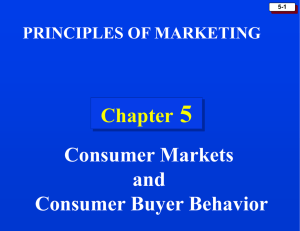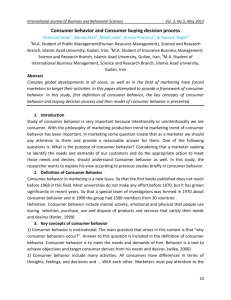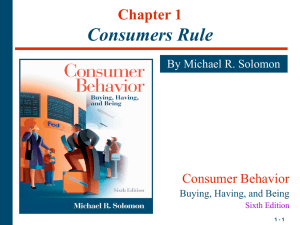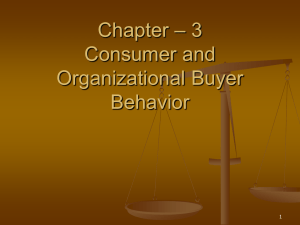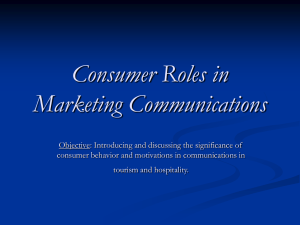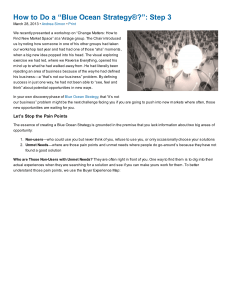The aim of marketing is to meet and satisfy target customers' needs
advertisement
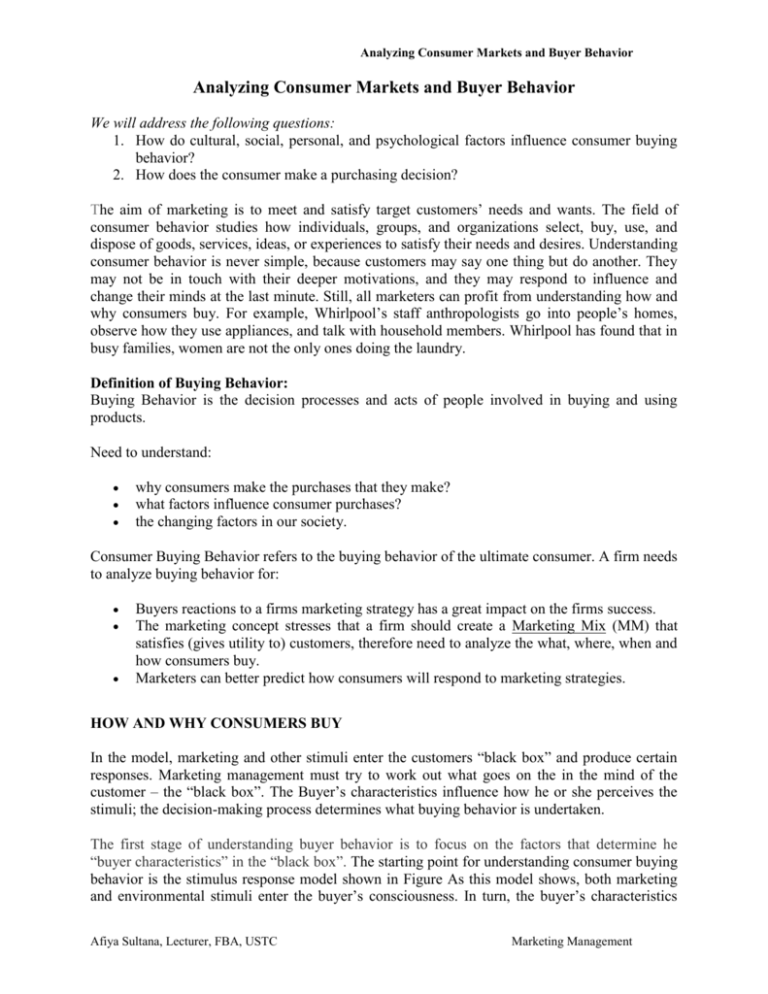
Analyzing Consumer Markets and Buyer Behavior Analyzing Consumer Markets and Buyer Behavior We will address the following questions: 1. How do cultural, social, personal, and psychological factors influence consumer buying behavior? 2. How does the consumer make a purchasing decision? The aim of marketing is to meet and satisfy target customers’ needs and wants. The field of consumer behavior studies how individuals, groups, and organizations select, buy, use, and dispose of goods, services, ideas, or experiences to satisfy their needs and desires. Understanding consumer behavior is never simple, because customers may say one thing but do another. They may not be in touch with their deeper motivations, and they may respond to influence and change their minds at the last minute. Still, all marketers can profit from understanding how and why consumers buy. For example, Whirlpool’s staff anthropologists go into people’s homes, observe how they use appliances, and talk with household members. Whirlpool has found that in busy families, women are not the only ones doing the laundry. Definition of Buying Behavior: Buying Behavior is the decision processes and acts of people involved in buying and using products. Need to understand: why consumers make the purchases that they make? what factors influence consumer purchases? the changing factors in our society. Consumer Buying Behavior refers to the buying behavior of the ultimate consumer. A firm needs to analyze buying behavior for: Buyers reactions to a firms marketing strategy has a great impact on the firms success. The marketing concept stresses that a firm should create a Marketing Mix (MM) that satisfies (gives utility to) customers, therefore need to analyze the what, where, when and how consumers buy. Marketers can better predict how consumers will respond to marketing strategies. HOW AND WHY CONSUMERS BUY In the model, marketing and other stimuli enter the customers “black box” and produce certain responses. Marketing management must try to work out what goes on the in the mind of the customer – the “black box”. The Buyer’s characteristics influence how he or she perceives the stimuli; the decision-making process determines what buying behavior is undertaken. The first stage of understanding buyer behavior is to focus on the factors that determine he “buyer characteristics” in the “black box”. The starting point for understanding consumer buying behavior is the stimulus response model shown in Figure As this model shows, both marketing and environmental stimuli enter the buyer’s consciousness. In turn, the buyer’s characteristics Afiya Sultana, Lecturer, FBA, USTC Marketing Management Analyzing Consumer Markets and Buyer Behavior and decision process lead to certain purchase decisions. The marketer’s task is to understand what happens in the buyer’s consciousness between the arrival of outside stimuli and the buyer’s purchase decisions. As this model indicates, a consumer’s buying behavior is influenced by cultural, social, personal, and psychological factors. Cultural Social Personal Psychological Factors Influencing Buyers’ Behavior a) Cultural Factors Influencing Buyer Behavior: Culture, subculture, and social class are particularly important influences on consumer buying behavior. Culture-Culture is the most fundamental determinant of a person’s wants and behavior. A child growing up in the United States is exposed to these broad cultural values: achievement and success, activity, efficiency and practicality, progress, material comfort, individualism, freedom, external comfort, humanitarianism, and youthfulness. Subculture-Each culture consists of smaller subcultures that provide more specific identification and socialization for their members. Subcultures include nationalities, religions, racial groups, and geographic regions. Many subcultures make up important market segments, leading marketers to tailor products and marketing programs to their needs. Latinos, for example, the fastest-growing U.S. subculture, are targeted by Dallas-based Carnival Food Stores, among other marketers. Dallas is one of the top 10 cities in terms of Latino population, and when the chain uses Spanish language promotions, customers are more responsive. Social class-Social classes are relatively homogeneous and enduring divisions in a society. They are hierarchically ordered and their members share similar values, interests, and behavior (see Table 1). Afiya Sultana, Lecturer, FBA, USTC Marketing Management Analyzing Consumer Markets and Buyer Behavior Cultural Factors Culture Sub-culture Social Social Factors Personal Factors Reference groups Family Social roles & statuses Age & stage in the life cycle Occupation & economic circumstances Lifestyle and personality & selfconcepts Psychological Factors Motivation Perception Learning Beliefs & attitudes Figure 1: Factors influencing buyers’ behavior. Social class is a status hierarchy by which groups and individuals are classified on the basis of esteem and prestige.—American Marketing Association. Characteristics of social class: Social classes reflect income as well as occupation, education, and other indicators. Those within each social class tend to behave more alike than do persons from different social classes. Also, within the culture, persons are perceived as occupying inferior or superior positions according to social class. Social class is indicated by a cluster of variables rather than by any single variable. Still, individuals can move from one social class to another—up or down—during their lifetime. Because social classes often show distinct product and brand preferences, some marketers focus their efforts on one social class. Thus, company presidents often drive Mercedes, wear expensive suits, and drink Chivas Regal scotch. Savvy marketers are aware of the status symbol potential of products and brands. b) Social Factors Influencing Buyer Behavior In addition to cultural factors, a consumer’s behavior is influenced by such social factors as reference groups, family, and social roles and statuses. Reference Groups- Reference groups consist of all of the groups that have a direct (face-toface) or indirect influence on a person’s attitudes or behavior. Groups that have a direct influence on a person are called membership groups. Some primary membership groups are family, friends, neighbors, and co-workers, with whom individuals interact fairly continuously and informally. Secondary groups, such as professional and trade-union groups, tend to be more formal and require less continuous interaction. Reference groups expose people to new behaviors and lifestyles, influence attitudes and self-concept, and create pressures for conformity that may affect product and brand choices. People are also influence by groups to which they do not belong. Aspirational groups are those the person hopes to join; dissociative groups are those whose values or behavior an individual rejects. Family -The family is the most important consumer-buying organization in society, and it has been researched extensively. The family of orientation consists of one’s parents and siblings. From parents, a person acquires an orientation toward religion, politics, and economics as well as Afiya Sultana, Lecturer, FBA, USTC Marketing Management Analyzing Consumer Markets and Buyer Behavior a sense of personal ambition, self-worth, and love. A more direct influence on the everyday buying behavior of adults is the family of procreation—namely, one’s spouse and children. Marketers are interested in the roles and relative influence of the husband, wife, and children in the purchase of a large variety of products and services. These roles vary widely in different cultures and social classes. Roles and Statuses A person participates in many groups, such as family, clubs, or organizations. The person’s position in each group can be defined in terms of role and status. A role consists of the activities that a person is expected to perform. Each role carries a status. Status refers to the position in a society. A Supreme Court justice has more status than a sales manager, and a sales manager has more status than an administrative assistant. In general, people choose products that communicate their role and status in society. c) Personal Factors Influencing Buyer Behavior Cultural and social factors are just two of the four major factors that influence consumer buying behavior. The third factor is personal characteristics, including the buyer’s age, stage in the life cycle, occupation, economic circumstances, lifestyle, personality, and self-concept. Age & stage in the life cycle: People buy different goods and services over a lifetime. They eat baby food in the early years, most foods in the growing and mature years and special diets in the later years. Taste in clothes, furniture and recreation is also age and life cycle related. People are influenced differently at the each of nine stages of his life-cycle. Occupation & economic circumstances: Product choice and consumption patterns are influenced by the occupation and economic circumstances such as spend-able income, savings & assets, debts & borrowing power and attitudes towards spending etc. Lifestyle: A lifestyle is a person’s pattern of living in the world as expressed in activities, interests and opinions. It portrays the whole person interacting with his environment. Personality & self-concept: Personality means a set of distinguishing human psychological characteristics such as self-confidence, dominance, autonomy, deference, sociability, defensiveness and adaptability. These characteristics as well as self-concept affect a person’s buying behavior greatly. d) Psychological Factors Influencing Buyer Behavior Psychological factors are the fourth major influence on consumer buying behavior (in addition to cultural, social, and personal factors). In general, a person’s buying choices are influenced by the psychological factors of motivation, perception, learning, beliefs, and attitudes. Motivation A person has many needs at any given time. Some needs are biogenic; they arise from physiological states of tension such as hunger, thirst, discomfort. Other needs are psychogenic; they arise from psychological states of tension such as the need for recognition, esteem, or belonging. A need becomes a motive when it is aroused to a sufficient level of intensity. A motive is a need that is sufficiently pressing to drive the person to act. Psychologists have developed theories of human motivation. Maslow’s theory: Abraham Maslow sought to explain why people are driven by particular needs at particular times. His theory is that human needs are arranged in a hierarchy, from the most to the least pressing. In order of importance, these categories are physiological, safety, social, esteem, and selfAfiya Sultana, Lecturer, FBA, USTC Marketing Management Analyzing Consumer Markets and Buyer Behavior actualization needs. A consumer will try to satisfy the most important need .rst; when that need is satisfied, the person will try to satisfy the next-most-pressing need. Maslow’s theory helps marketers understand how various products .t into the plans, goals, and lives of consumers. Herzberg’s theory. Frederick Herzberg developed a two-factor theory that distinguishes dissatisfiers (factors that cause dissatisfaction) from satisfiers (factors that cause satisfaction).The absence of dissatisfiers is not enough; satisfiers must be actively present to motivate a purchase. For example, a computer that comes without a warranty would be a dissatisfier. Yet the presence of a product warranty would not act as a satisfier or motivator of a purchase. Ease of use would, however, be a satisfier or a computer buyer. In line with this theory, marketers should avoid dissatisfiers that might sell their products. They should also identify and supply the major satisfiers or motivators of purchase, because these satisfiers determine which brand consumers will buy. Perception A motivated person is ready to act, yet how that person actually acts is influenced by is or her perception of the situation. Perception is the process by which an individual elects, organizes, and interprets information inputs to create a meaningful picture f the world. Perception depends not only on physical stimuli. Individuals can have different perceptions of the same object because of three perceptual processes: selective attention, selective distortion, and selective retention. Selective attention: People are exposed to many daily stimuli such as ads; most of these stimuli are screened out—a process called selective attention. The end result is that marketers have to work hard to attract consumers’ attention. Through research, marketers have learned that people are more likely to notice stimuli that relate to a current need, which is why car shoppers notice car ads but not appliance ads. Selective distortion: Even noticed stimuli do not always come across the way that marketers intend. Selective distortion is the tendency to twist information into personal meanings and interpret information in a way that fits our preconceptions. Unfortunately, marketers can do little about selective distortion. Selective retention: People forget much that they learn but tend to retain information that supports their attitudes and beliefs. Because of selective retention, we are likely to remember good points mentioned about a product we like and forget good points mentioned about competing products. Selective retention explains why marketers use drama and repetition in messages to target audiences. Learning: It involves changes in an individual’s behavior arising from experience. Most human behavior is learned. Beliefs & attitudes: Through doing and learning people acquire beliefs and attitudes. A belief is a person’s descriptive thought about something and attitude is a person’s enduring evaluations, feelings and action towards some object or idea. The Stages of the Buying Decision Process In addition to examining buying roles and behavior, smart companies research the buying decision process involved in their product category. They ask consumers when they first became acquainted with the product category and brands, what their brand beliefs are, how involved they are with the product, how they make their brand choices, and how satisfied they are after purchase. Afiya Sultana, Lecturer, FBA, USTC Marketing Management Analyzing Consumer Markets and Buyer Behavior Figure shows a five-stage model of the typical buying process. Starting with problem recognition, the consumer passes through the stages of information search, evaluation of alternatives, purchase decision, and post purchase behavior. As this model demonstrates, the consumer buying process starts long before the actual purchase and has consequences long afterward. Although the model implies that consumers pass sequentially through all five stages in buying a product, consumers sometimes skip or reverse some stages. Problem Recognition Information Search Evaluation of Alternatives Purchase Decision Post Purchase Decision Figure 2 Five-Stage Model of the Consumer Buying Process Stage 1: Problem Recognition The buying process starts when the buyer recognizes a problem or need. This need can be triggered by internal stimuli (such as feeling hunger or thirst) or external stimuli (such as seeing an ad) that then becomes a drive. By gathering information from a number of consumers, marketers can identify the most frequent stimuli that spark interest in a product category. They can then develop marketing strategies that trigger consumer interest and lead to the second stage in the buying process. Stage 2: Information Search Information search: The stage of the buyer decision process in which the consumers search for more information about the ways to satisfy their needs. For example, once a person decides to buy a car, automatically s/he will pay more attention to car ads and will discuss with friends or acquaintances who own a car. Consumers can obtain information from several sources, like Personal sources (family, friends, neighbors, acquaintances etc); Commercial sources (advertising, sales people, dealers, packaging etc); public sources (mass media, consumer rating organization etc), and experiential sources (handling, testing and using the product) Stage 3: Evaluation of Alternatives Once the consumer has conducted an information search, how does he or she process competitive brand information and make a final judgment? There are several evaluation processes; the most current models view the process as being cognitively oriented, meaning that consumers form judgments largely on a conscious and rational basis. Some basic concepts underlie consumer evaluation processes. As noted earlier, the consumer is trying to satisfy a need. In seeking certain benefits from the product solution, the consumer sees each product as a bundle of attributes with varying abilities of delivering the benefits to satisfy this need. However, the attributes of interest to buyers vary by product. For example, the attributes sought in a camera might be picture sharpness, camera size, and price. In addition, consumers vary as to which product attributes they see as most relevant and the importance they attach to each attribute. Knowing that consumers pay the most attention to attributes that deliver the benefits they seek, many successful marketers segment their markets according to the attributes that are salient to different consumer groups. Afiya Sultana, Lecturer, FBA, USTC Marketing Management Analyzing Consumer Markets and Buyer Behavior Stage 4: Purchase Decision In the evaluation stage, the consumer forms preferences among the brands in the choice set and may also form an intention to buy the most preferred brand. However, two factors can intervene between the purchase intention and the purchase decision. The first factor is the attitudes of others. The extent to which another person’s attitude reduces one’s preferred alternative depends on two things: (1) the intensity of the other person’s negative attitude toward the consumer’s preferred alternative, and (2) the consumer’s motivation to comply with the other person’s wishes. The second factor is unanticipated situational factors that may erupt to change the purchase intention. A consumer could lose his job, some other purchase might become more urgent, or a store salesperson may turn him or her off, which is why preferences and even purchase intentions are not completely reliable predictors of purchase behavior. Stage 5: Postpurchase Behavior After purchasing the product, the consumer moves into the final stage of the consumer buying process, in which he or she will experience some level of satisfaction or The Consumer Buying Decision Process dissatisfaction. This is why the marketer’s job does not end when the product is bought. In particular, marketers must monitor postpurchase satisfaction, postpurchase actions, and postpurchase product uses. Postpurchase Satisfaction The buyer’s satisfaction with a purchase is a function of the closeness between the buyer’s expectations and the product’s perceived performance. If performance falls short of expectations, the customer is disappointed; if it meets expectations, the customer is satisfied; if it exceeds expectations, the customer is delighted. These feelings of satisfaction influence whether the customer buys the product again and talks favorably or unfavorably about the product to others. The importance of postpurchase satisfaction suggests that product claims must truthfully represent the product’s likely performance. Some sellers might even understate performance levels so that consumers experience higher-than-expected satisfaction with the product. Postpurchase Actions The consumer’s satisfaction or dissatisfaction with the product after purchase will influence subsequent behavior. Satisfied consumers will be more likely to purchase the product again. This has been confirmed by the data on automobile brand choice, which show a high correlation between satisfaction with the last brand bought and intention to rebuy the brand. One survey showed that 75 percent of Toyota buyers were highly satisfied and about 75 percent intended to buy a Toyota again. Satisfied customers also tend to say good things about the brand to others, which is why many marketers say: “Our best advertisement is a satisfied customer.” Dissatisfied consumers, on the other hand, may abandon or return the product; seek information that confirms its high value; take public action by complaining to the company, going to a lawyer, or complaining to government agencies and other groups; or take private actions such as not buying the product or warning friends. Marketers can use postpurchase communications to buyers as a way to reduce product returns and order cancellations. Computer companies, for example, might take a number of actions, including sending e-mail messages to new buyers congratulating them on having selected a fine computer, placing ads showing satisfied brand owners, soliciting customer suggestions for improvements, and providing channels for speedy resolution of customer complaints. Afiya Sultana, Lecturer, FBA, USTC Marketing Management Analyzing Consumer Markets and Buyer Behavior Postpurchase Use and Disposal Marketers should also monitor how buyers use and dispose of the product after purchase. If consumers store the product and never use it, the product is probably not very satisfying, and word-of-mouth will not be strong. If they sell or trade the product, new-product sales will be depressed. If consumers throw the product away, the marketer needs to consider how they dispose of it, especially if it can hurt the environment. For example, increased public awareness of recycling and ecological concerns about having to throw away beautiful bottles led French perfume maker Rochas to think about introducing a new, refillable bottle fragrance line. This is a more creative, satisfying response to an element that could potentially cause dissatisfaction among buyers. Afiya Sultana, Lecturer, FBA, USTC Marketing Management
